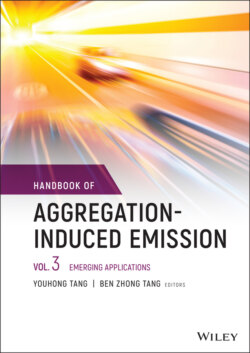Читать книгу Handbook of Aggregation-Induced Emission, Volume 3 - Группа авторов - Страница 35
2.8 Conclusions and Outlook
ОглавлениеIn this chapter, we have shown various strategies for the construction of a diverse array of AICPL materials. The combination of chiral units and AIEgens was proven to be an efficient way to build small organic AICPL molecules, as well as AICPL metal complexes and clusters. While in macrocycles and cages, the chirality of TPE‐type AIEgens can be fixed and this has been demonstrated as a practical access to AICPL. The supramolecular, polymers, and LC systems derived from a series of AIEgens also showed outstanding AICPL performance with both high quantum yields and large glum values. These AICPL materials are highly useful for potential applications in CP–OLEDs, 3D displays, data storage and processing, and anti‐counterfeiting technology. Beside, considering the fact that achiral AIE‐active materials have been widely applied in bio‐systems, we anticipate the introduction of chirality will inspire the design of new‐generation CPL biosensors and bioprobes. Thus, AICPL materials with an additional dimension of chirality are supposed to promote biomedical research. We believe that in the near future, with continued progress in the fabrication of advanced AICPL materials, more possibilities will be realized.
